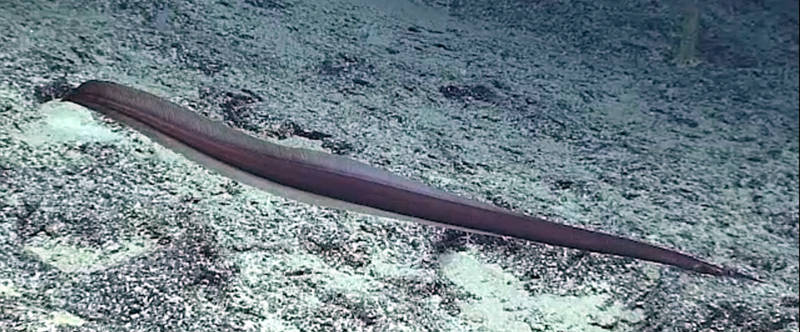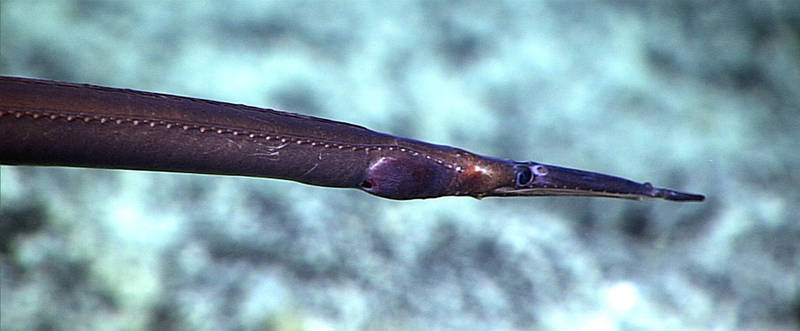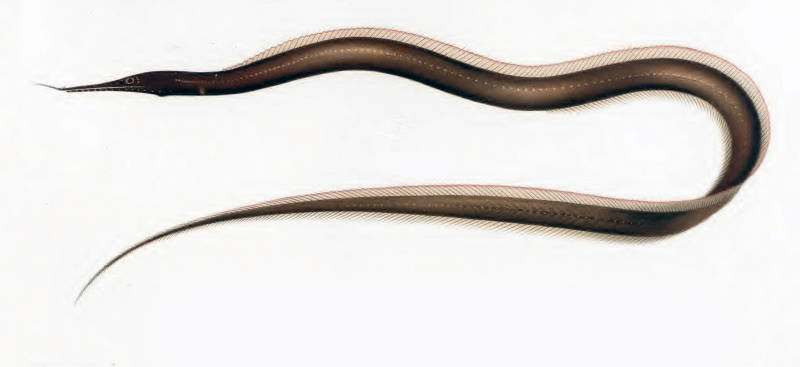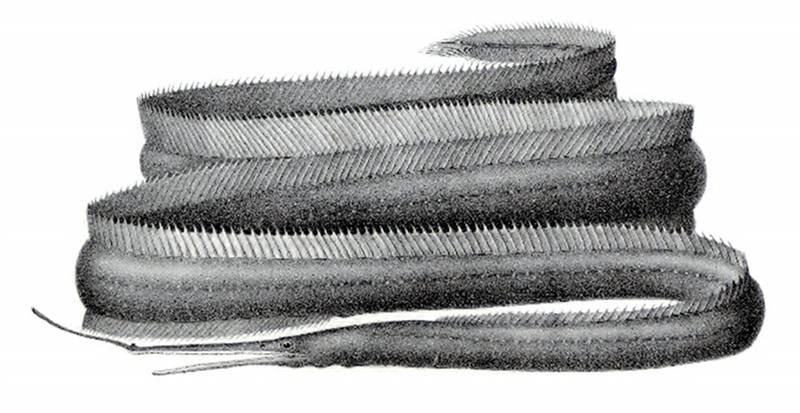
By Bruce Mundy - Fishery Biologist, NOAA National Marine Fisheries Service, Pacific Islands Fisheries Science Center
September 1, 2015

This unusual eel was filmed during the Hohonu Moana expedition’s remotely operated vehicle dive almost a mile below the sea surface, at a terrace near Gardner Pinnacles in the Papahānaumokuākea National Marine Monument, on August 17, 2015. Image courtesy of the NOAA Office of Ocean Exploration and Research, 2015 Hohonu Moana. Download larger version (jpg, 430 KB).
Exploration is well known to reveal discoveries, but it also reveals mysteries. Sometimes, both discovery and mystery have unexpected connections to the distant past. This mission log is about a link between the sorceresses of ancient Rome and a discovery by Okeanos Explorer scientists.
During the Hohonu Moana expedition’s remotely operated vehicle dive on August 17, 2015, we saw a very unusual eel with a long, fleshy extension from its nose. Swimming a mile below the sea surface at a terrace near Gardner Pinnacles in the Papahānaumokuākea National Marine Monument, this eel was both a discovery and a mystery.

The eel had an unusual fleshy extension from the snout. The anterior nostril is above the front of the lower jaw, and the posterior nostril is large and directly in front of the eye. A number of the sensory pores on the body and the head can be seen as small white dots. Image courtesy of the NOAA Office of Ocean Exploration and Research, 2015 Hohonu Moana. Download larger version (jpg, 410 KB).
Dr. Chris Kelley, one of the two scientists onboard the Okeanos Explorer, immediately recognized the eel's taxonomic family. He didn’t tell the shore-side fish experts what kind of eel he thought it was — instead, he mischievously left it a puzzle for us.
We knew that the fish was a duckbill eel — an eel from the family Nettastomatidae. In Hawaiian waters, researchers have, in the past, collected four species of duckbill eels in their adult forms (a fifth species is known only from its larval stage). But none of the species known from adults has a long, fleshy extension of the snout like the eel that we saw.
Rather, the long snout is an identifying characteristic of the nettastomatidae genus Venefica, which has never been caught in Hawaiian waters and is very poorly known because few specimens have been collected elsewhere. But based on these specimens, we know that Venefica grow to a length of about one meter (39 inches); live in deep water; have bodies with high oil content; are very fragile; and appear to be poor swimmers, probably to conserve energy in their deep-water habitat where temperatures are very cold and food is scarce. There is almost no information about other aspects of their biology or ecology.

Venefica procera is an Atlantic species with a short extension on the snout. Oceanic Ichthyology, a treatise on the deep-sea and pelagic fishes of the world.... Special Bulletin of the United States National Museum, Number l. Download image (jpg, 26 KB).
We don’t know what species of Venefica we saw.
The five described species of Venefica differ primarily in the length of the extension of the nose, the form and position of the nostrils, the number sensory pores on the head, and the number of vertebrae, tooth patterns, and other things that can’t be seen in photographs or videos, according to Dr. David Smith, an ichthyologist of the U.S. National Museum of Natural History.
Other ichthyologists have suggested that there may be other species that are undescribed, though more research is needed to determine how many species exist worldwide and how they can be identified. In the paper by Dr. Smith and the late Dr. Peter Castle that described the unidentified duckbill eel larvae from Hawaiian waters, they suggested that the larvae may be those of Venefica, but we won’t know what the species is until we collect adult specimens.

Venefica tentaculata, an eastern and central Pacific species with a moderately long extension on the snout. This is the species of Venefica that has been reported closest to the Hawaiian Islands. Reports on an exploration off the west coasts of Mexico, Central and South America, and the Galapagos Islands... by the U. S. Fish Commission steamer "Albatross," during 1891: the fishes. Memoirs of the Museum of Comparative Zoology, number 24. Download larger version (jpg, 328 KB).
Among the known Venefica species, researchers have recorded Venefica tentaculata closest to the Hawaiian Islands, from the Mid-Pacific Seamounts to the west. It often has a longer extension of the nose than the eel we saw during the Okeanos Explorer dive, but some specimens may have shorter snouts.
Venefica proboscidea is a species with a short snout like the one that we saw — it has not been reported from the central Pacific, but has been found in the western Pacific, from Japan to Vanuatu.
This information, however, doesn't allow us to identify what species we saw. This mystery is not yet solved.
What is the connection to the sorceress?

Venefica ocella is an eastern Pacific species with a very long extension on the snout. Reports on an Exploration Off the West Coasts of Mexico, Central and South America, and the Galapagos Islands... by the U. S. Fish Commission Steamer "Albatross," During 1891: The Fishes. Memoirs of the Museum of Comparative Zoology, number 24. Download image (jpg, 58 KB).
A venefica was an ancient Roman sorceress or witch who used potions and poisons. In Latin, the word actually means “a woman who poisons.” American ichthyologists David Starr Jordan and Bradley Moore Davis named the Venefica eel in 1891, a few years before the research vessel Albatross conducted the first explorations of deep waters of the Hawaiian Islands. Latin and Greek are the traditionally preferred languages for new scientific names.
Jordan and Davis named these fish Venefica because a sorcière (witch) is the colloquial French name for a related type of duckbill eel, Nettastoma melanurum, in Nice, on the Mediterranean Sea. They chose the Latin version of the word instead of the French one because of scientific tradition at the time. Venefica eels are, therefore, called witch eels in translation to English.
Did Jordan and Davis know that the venefica of ancient Rome used potions and poisons? Would they have used the name if they had? We may never know.
The discovery of this eel during the Okeanos Explorer expedition has left us with more than one mystery.